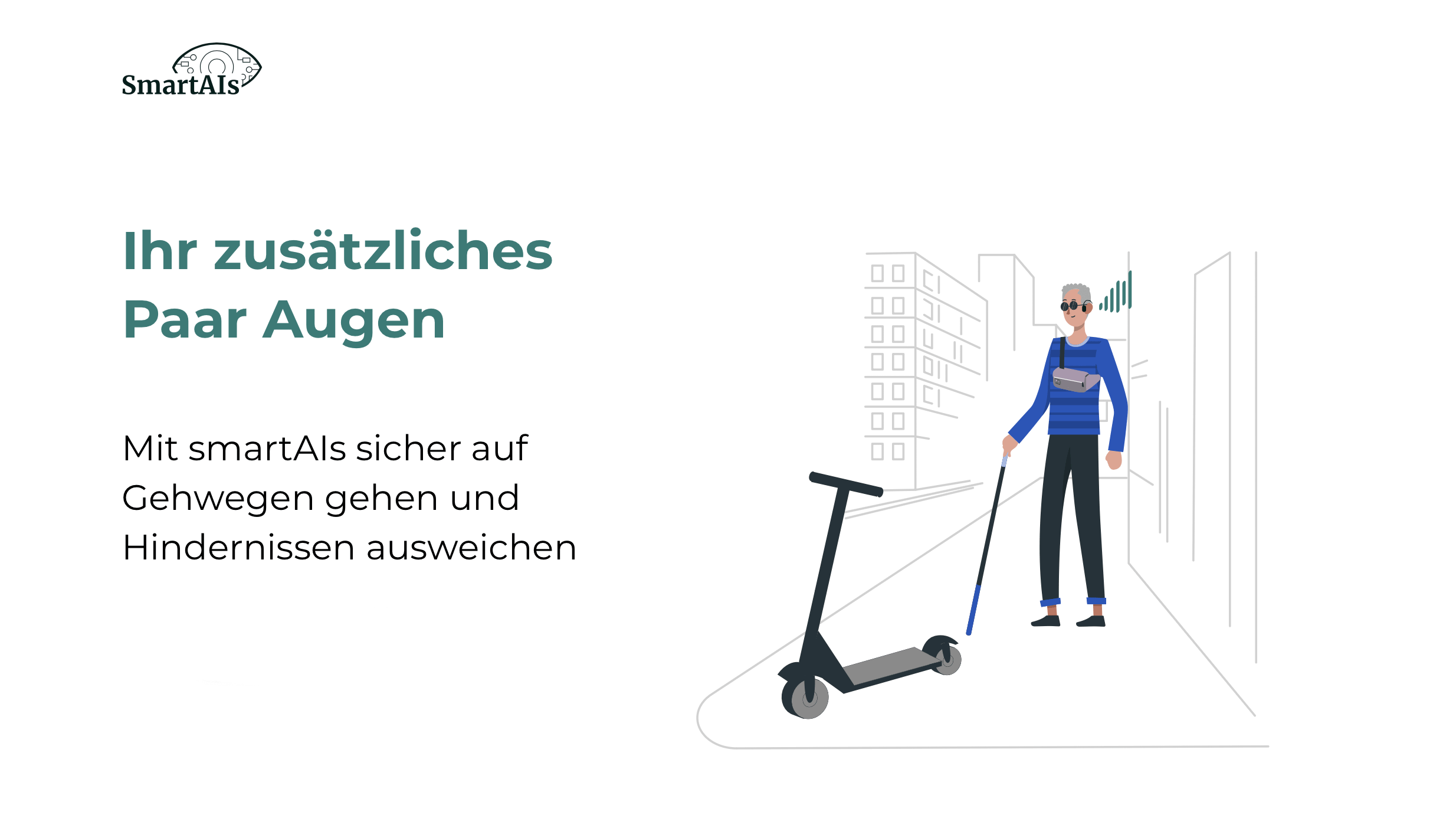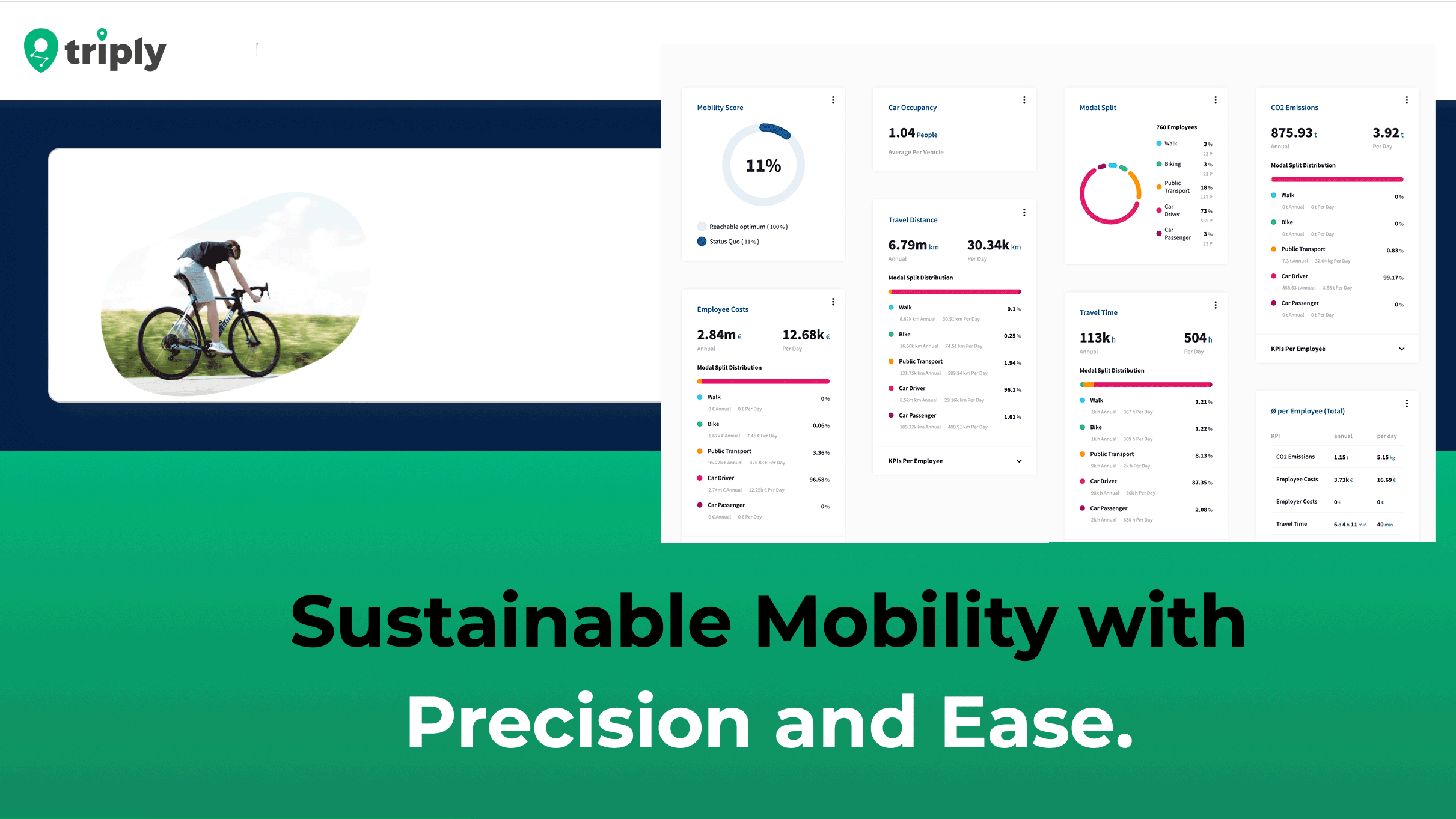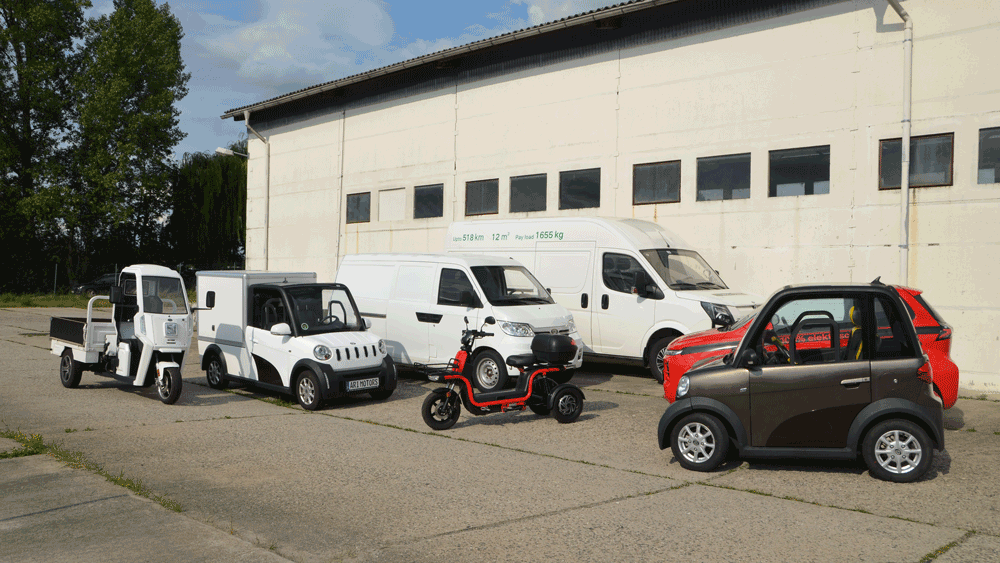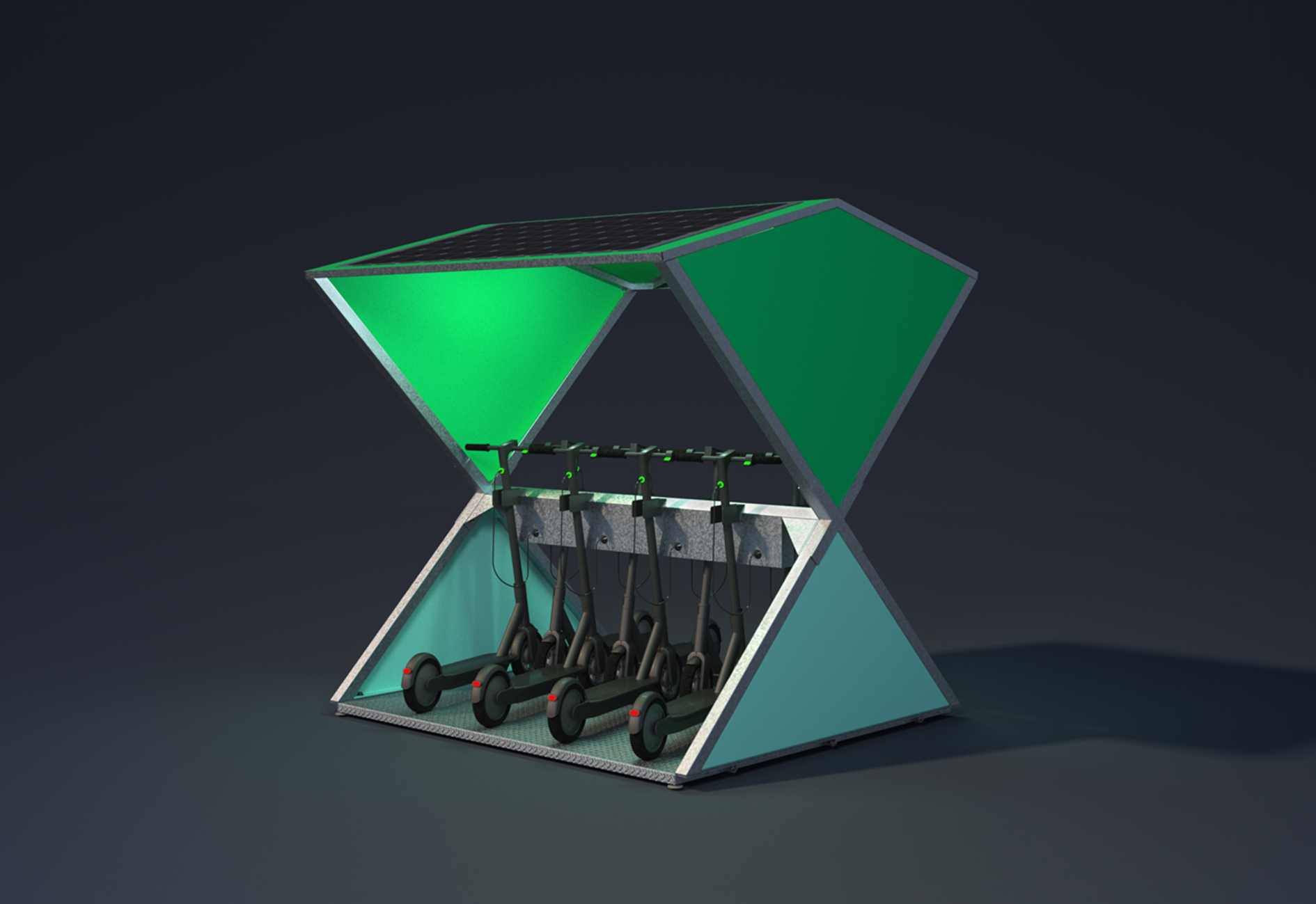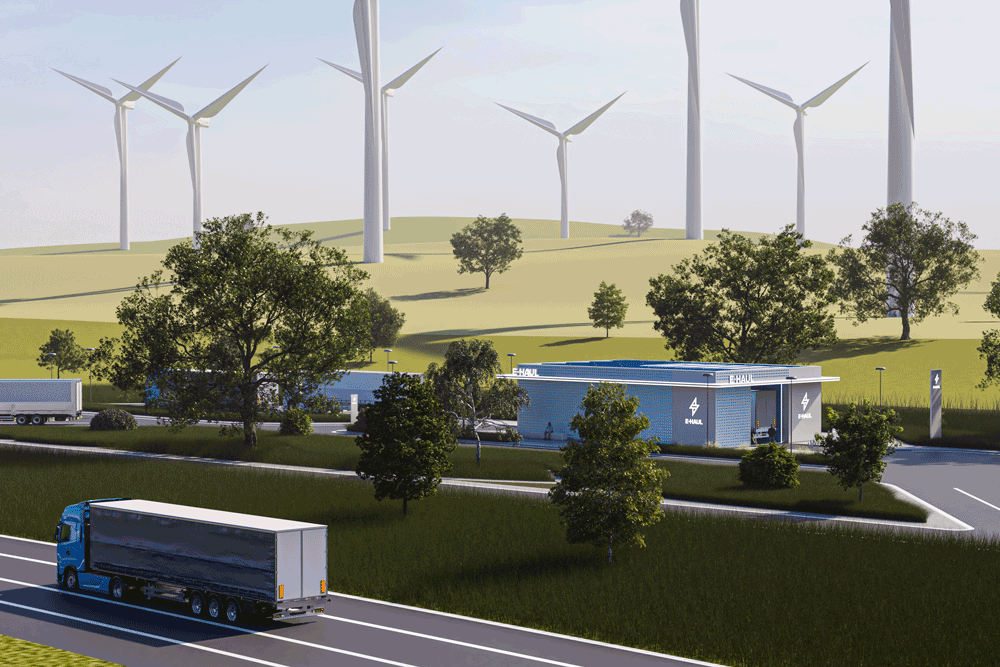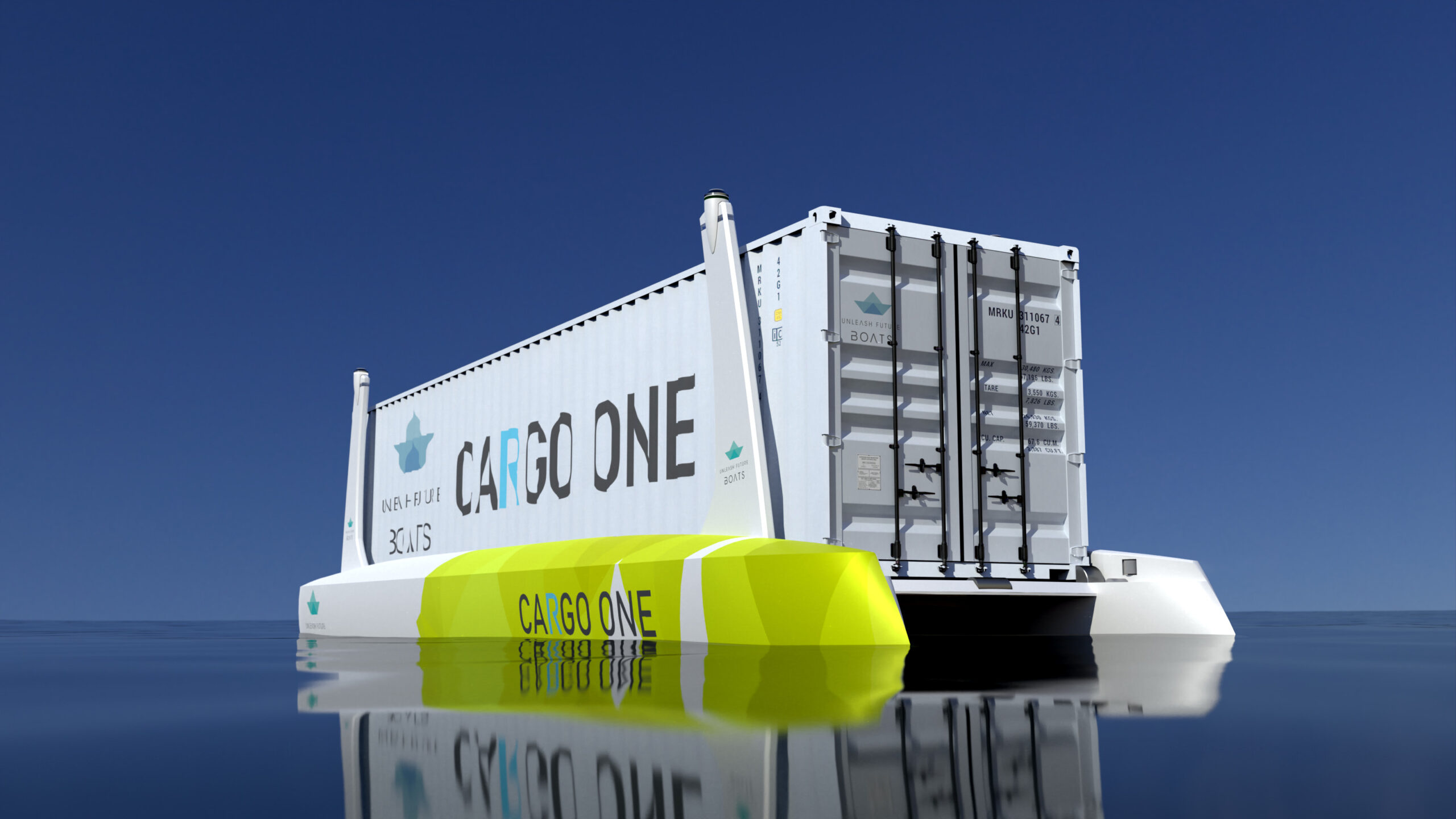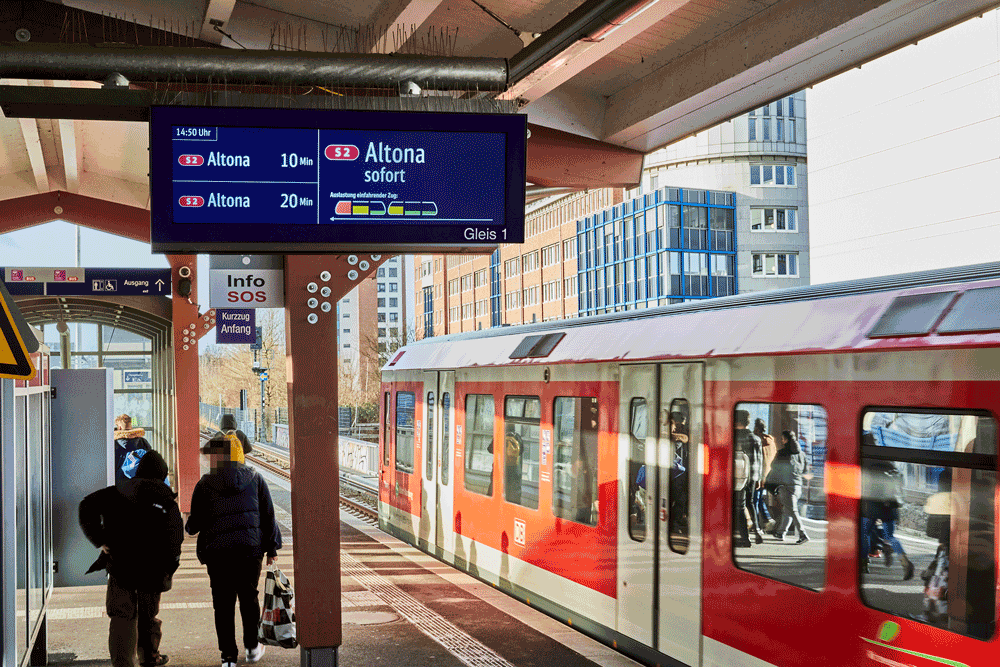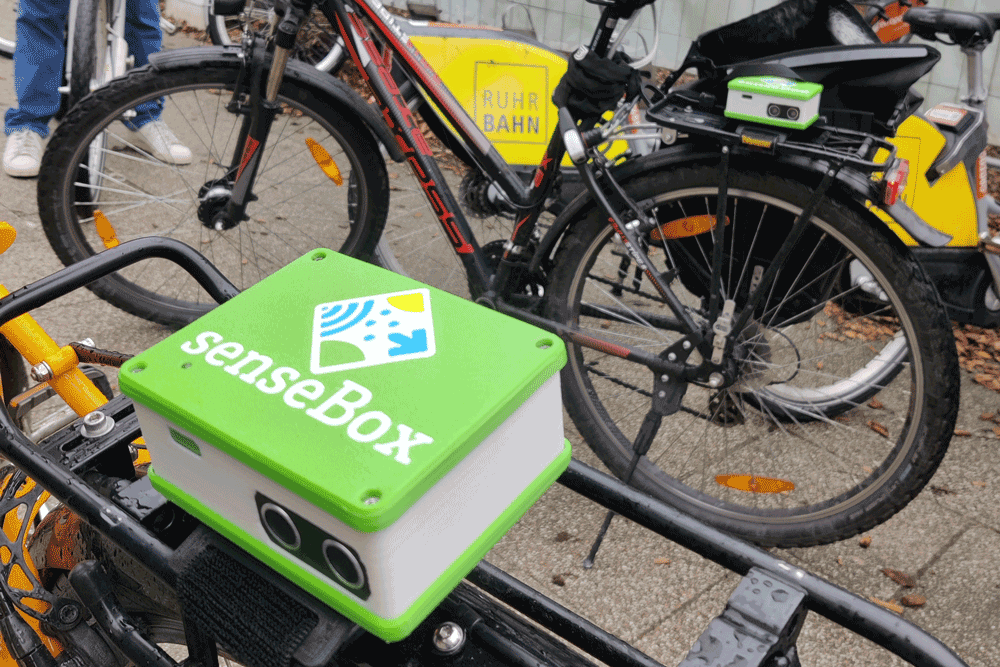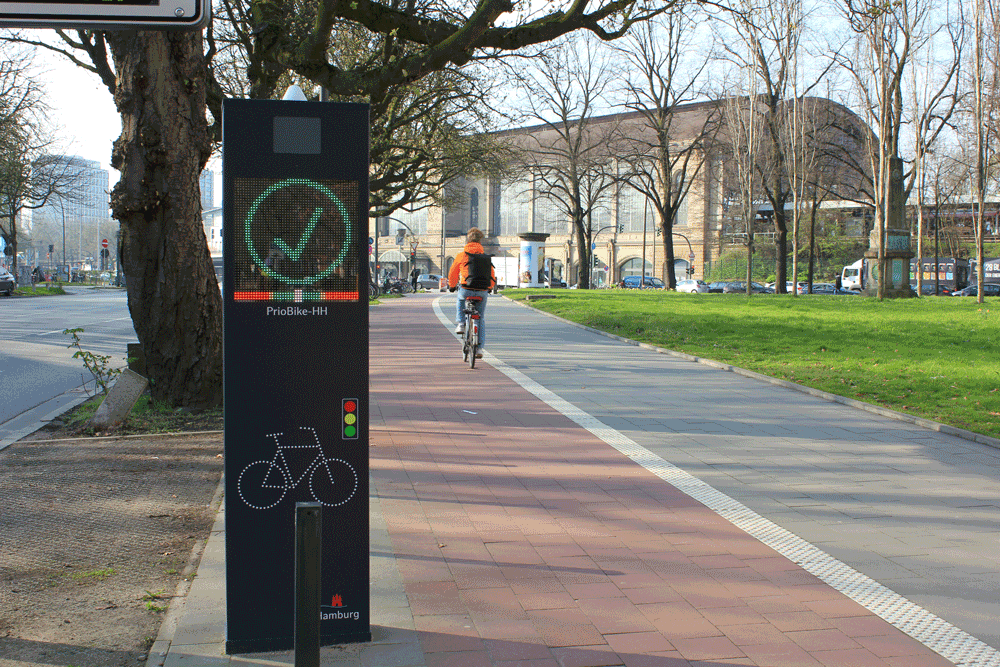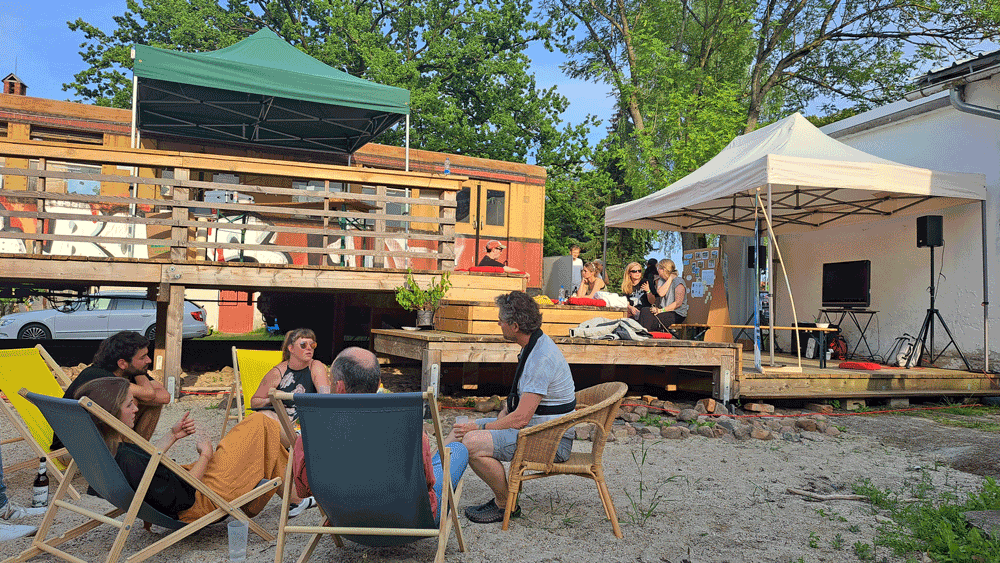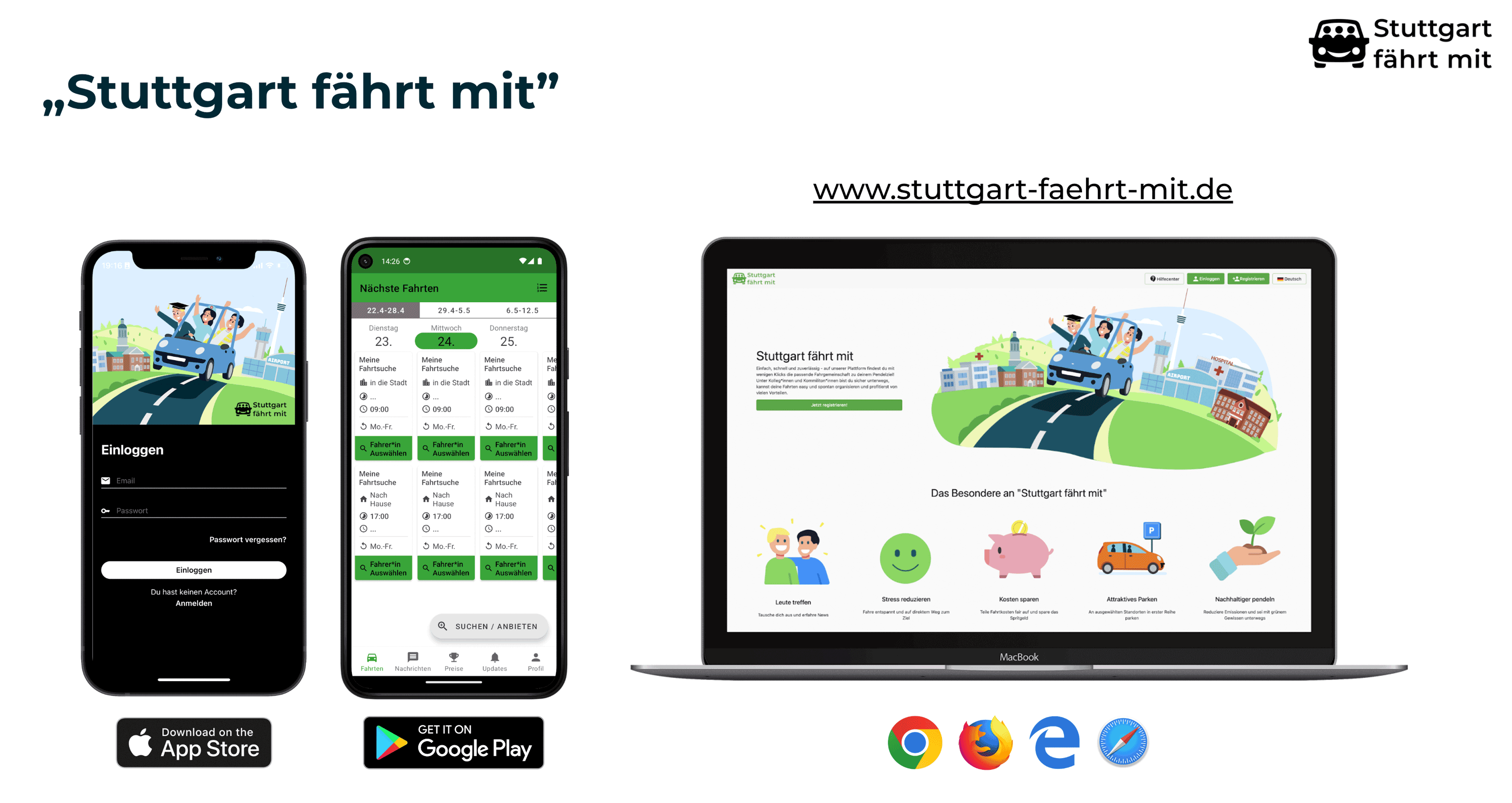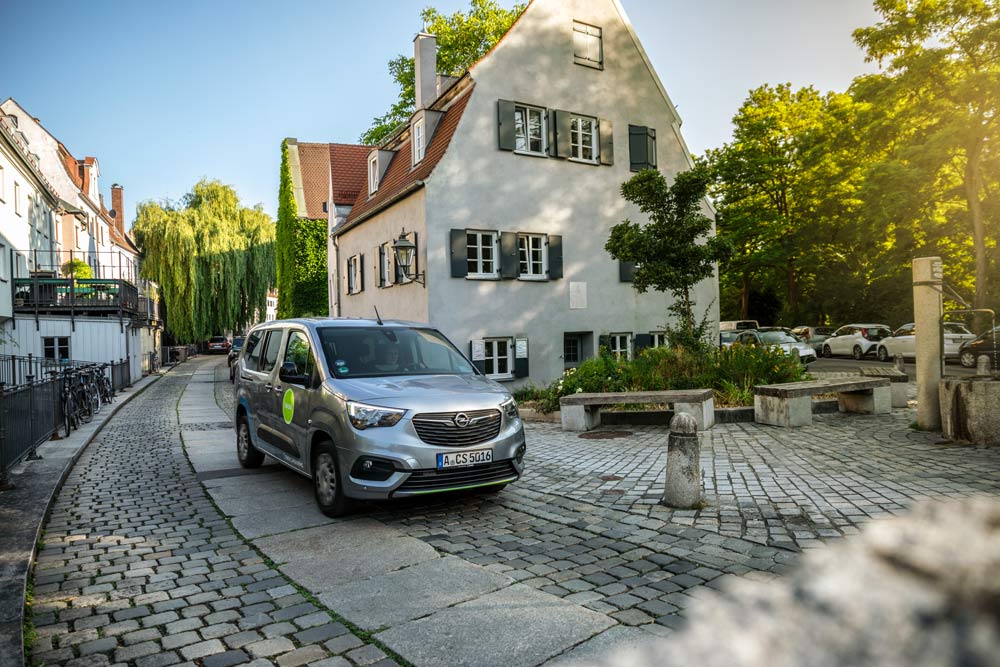Longlist 2024
DMP | Digital Transformation and AI
AORTA - Automated rescue lanes through intelligent networking
AORTA - Automated rescue lanes through intelligent networking
If road users form an emergency lane too slowly or incompletely, emergency services are unnecessarily delayed. The project team is developing and testing a system that supports the automated formation of emergency lanes. It uses digital technologies that enable vehicles to send their current position and driving data to other vehicles in real time and process the data from other vehicles. Based on this, the system issues instructions to the drivers. It also integrates automated vehicles that manoeuvre themselves – independently of a driver – into the position required for the emergency lane. The system uses digital twins to coordinate vehicle movements.
Location: Kaiserslautern (Rhineland-Palatinate)
Project Website Project Website
DaQuAI - Using AI to check the quality of Hamburg's traffic data
DaQuAI - Using AI to check the quality of Hamburg's traffic data
Automated counting stations in Hamburg provide 650,000 data records on the traffic of cyclists and motor vehicles every day. They are used by the city administration to record movements, derive actual needs and build and redesign traffic routes on this basis. However, weather events, roadworks or greenery often lead to measurement errors in the thermal imaging cameras used. With the help of artificial intelligence, the project team wants to take these and other influencing factors into account to improve the quality of the traffic count data and increase the benefits for traffic route planning.
Location: Hamburg (Hamburg)
Project Website Project WebsiteFuturail - The future of self-driving trains
Futurail - The future of self-driving trains
Locomotives and railcars need a large number of cameras, sensors and control elements to be able to run driverless. These need to record and analyse what is happening on and next to the tracks, as well as which signals trains should send and where they should stop. In the Futurail project, the participants are developing and testing a control system that also utilises artificial intelligence. With this they analyse numerous route data recorded under different weather conditions. From this, it calculates models for the automated obstacle detection and track monitoring of autonomous locomotives and railcars. As part of the project, the team also wants to improve the exchange of data between railway operating systems in order to optimise rail traffic.
Location: Munich (Bavaria) & Strasbourg (France)
Project Website Project WebsiteGINT - High-bandwidth mobile technologies for rail travellers and rail operations
GINT - High-bandwidth mobile technologies for rail travellers and rail operations
The GINT project consortium is installing and testing a new technology to provide train passengers with continuous mobile phone reception with a high bandwidth. This is based on a large number of relatively small masts that are set up at comparatively short intervals along the railway tracks. The masts are connected to fibre optic cables and linked to the data network. The aim is to provide uninterrupted mobile communications coverage for rail travellers with a high bandwidth of five gigabits (5G). In addition to mobile communications for travellers, the new masts will also be equipped with technology for modern railway radio, which train drivers, railway staff, control centres and signal boxes can use to communicate and exchange data with each other.
Location: Berlin (Berlin)
Project Website Project Website
Klima-Taler APP - Gamification for increased citizen engagement
Klima-Taler APP - Gamification for increased citizen engagement
The Klima-Taler app calculates how much CO2 a person avoids by travelling on foot, by bike or by public transport. To do this, it records the distances travelled and twelve different automatically recognized types of mobility. Based on average emission values and other factors, the software calculates the amount of CO2 saved. Users receive a climate token for every five kilograms they save. They can exchange this for discounts, for example in municipal theatres, museums or swimming pools as well as in local shops. The reward system is intended to motivate citizens to travel with less CO2 or completely emission-free. In addition, the analyses of the mobility data should help local authorities to align their transport and route planning with the needs of their residents.
Location: Berlin (Berlin)
Project Website Project WebsiteMobilityGPT - An innovative and voice-controlled mobility agent
MobilityGPT - An innovative and voice-controlled mobility agent
MobilityGPT utilises the ability of generative AI to understand and process natural language. The aim is to enable users of mobility services to speak or write their enquiries about connections or travel options freely instead of having to fill in input fields or operate menus. With the help of AI, the system recognises the essential information and searches for journey times and connection data. It offers this information to users – also in multiple languages – in spoken or written form, as well as the purchase of travelcards. With its technology and a development kit, the project team is targeting transport companies and specialised mobility service providers. The aim is to remove barriers to the use of mobility services, e.g. for blind and visually impaired people.
Location: Aachen (North Rhine-Westphalia)
Project Website Project WebsiteMoveOn – Cycling data for Germany
MoveOn – Cycling data for Germany
MoveOn accesses data that is collected and collated as part of the nationwide cycling campaign ‘Stadtradeln’. Over 475,000 participants in more than 2,800 municipalities record their cycle journeys via app – around seven million per year. The MoveOn team analyses this data and makes it available to the participating municipalities free of charge as a basic analysis. To do this, they prepare the data obtained for six application scenarios. For example, as user statistics, graphically prepared ‘heat maps’ or as an analysis of waiting times at junctions. These planning tools can be used directly via a web browser. Employees in over 700 local authorities currently use the data for local transport planning.
Location: Dresden (Saxony)
Project Website Project WebsiteSmartAIs - Obstacle detection app for blind and visually impaired people
SmartAIs - Obstacle detection app for blind and visually impaired people
SmartAIs make it possible for a smartphone to assist blind and visually impaired people by recognising their surroundings and alerting them to special conditions and obstacles in their way. To do this, they carry the smartphone in a special breast pocket. The app uses the smartphone’s camera as well as technologies from the fields of computer vision, robotics and autonomous driving to calculate corresponding messages in real time from the images taken. The calculations are carried out using AI-based technologies and take place entirely on the smartphone. The project team is cooperating with blind and visually impaired people who are testing the app in real-life situations, as well as with major German stakeholder associations and institutions who are contributing their expertise in the field of aids for the blind.
Location: Munich (Bavaria)
Project Website Project Website
triply Mobility Audit - analyses and solutions for professional mobility
triply Mobility Audit - analyses and solutions for professional mobility
triply is a data-based service platform that companies can use to make their employees offers for their mobility behaviour. The software analyses employee mobility, taking into account company structures, employee locations and environmental conditions as well as the number of employees, congestion data, cycle routes, altitude profiles and seasonal changes. It processes the location and movement data anonymously and also uses AI-supported technologies to create mobility and emissions analyses from all the data collected. These analyses contain comprehensible insights and graphics on the mobility patterns of the companies. The aim is to improve the carbon footprint of employees and companies and reduce costs.
Location: Linz (Austria)
Project Website Project WebsiteDMP | New Mobility Solutions
Bonvoyo - payment method for employer-funded mobility budgets
Bonvoyo - payment method for employer-funded mobility budgets
With Bonvoyo, Deutsche Bahn Connect offers interested companies a platform that allows them to set up mobility budgets for their employees. This budget can be used differently depending on the mode of transport chosen by the employee in the associated app. At the same time, the app suggests alternative modes of transport that are less harmful to the environment. In addition, Bonvoyo, which is also integrated into Deutsche Bahn’s Navigator app, allows employees to settle their travel directly with their employer without having to pay in advance. The aim of the Bonvoyo platform is to reduce employees’ mobility behaviour and CO2 emissions, thereby also reducing the company’s environmental impact.
Location: Frankfurt on the Main, Hesse
Project Website Project Website
Campus FreeCity - Real-world laboratory for research into networked modular robotic vehicles
Campus FreeCity - Real-world laboratory for research into networked modular robotic vehicles
The Campus FreeCity project focuses on laboratory-scale modular robotic vehicles called ‘EDAG CityBots’. They are used in a real-world laboratory for passenger and freight transport and can be equipped and deployed with different utility modules as required. A control system is being developed for route planning and the use of the CityBots in 24-hour continuous operation. Scenarios include tourists requesting transport to the nearest tourist attraction and a shop owner planning the delivery of goods for the next day. As part of the project, the participants are investigating a number of challenges and possible solutions to this approach, including acceptance and trust in such systems.
Location: Frankfurt on the Main (Hesse)
Project Website Project WebsiteCargoSurfer - Platform for unused cargo space in passenger and freight transport
CargoSurfer - Platform for unused cargo space in passenger and freight transport
Unnecessary empty runs of trucks, trailers or wagons occur in freight and passenger transport. CargoSurfer is a data-driven and AI-supported brokerage and booking platform that aims to increase the utilisation of these modes of transport and thus contribute to environmental relief. The system allows transport companies and service providers to enter their unused cargo capacity from planned passenger and freight journeys, and allows shippers to inquire about and book these spaces. The platform automates the pick-up, delivery and intermediate storage of goods for small shipments and links reported unused space to transport chains, even across different modes.
Location: Frankfurt (Oder) (Brandenburg)
Project Website Project WebsiteITS-CUBE - Cooperative Intelligent Transport Systems in favour of public transport
ITS-CUBE - Cooperative Intelligent Transport Systems in favour of public transport
In order to improve the performance of public transport buses in urban traffic, the city of Hamburg has launched the ITS-CUBE project, a digital transport system based on C-ITS technology. Among other things, it regulates the digital communication between so-called ‘on-board units’ in the buses and ‘roadside units’ at the traffic lights. This makes it possible, among other things, to prioritise buses at junctions, which helps to shorten journey times, reduce braking and optimise traffic flow – thus giving public transport more priority and making it more attractive. The aim is to install C-ITS solutions in 2,000 buses and 600 junctions by 2030. At the same time, the C-ITS technology, which is and will be installed throughout Europe, is intended to increase road safety.
Location: Hamburg (Hamburg)
Project Website Project WebsiteKIRA - AI-based regular operation of autonomous public transport vehicles
KIRA - AI-based regular operation of autonomous public transport vehicles
As part of KIRA, the project team is testing autonomous public transport vehicles that comply with the Level 4 standard for autonomous driving. The tests are carried out with six autonomous shuttle vehicles operating in urban and rural areas of the city of Darmstadt and the district of Offenbach. They will travel at standard speeds in normal road traffic within a defined service area. Test users will be given the opportunity to ride along, with safety personnel on board at all times during the test. In addition to the technology, the project will also test approval processes, operation, technical monitoring, interior management, customer processes and the control platform. The aim is to facilitate and accelerate the integration of autonomous on-demand fleets into regional public transport services. KIRA is initiated by DB Regio and the Rhein-Main-Verkehrsverbund (RMV).
Location: Darmstadt and Offenbach district (Hesse)
Project Website Project Website
KRAVAG Truck Parking - Sharing platform for truck parking spaces
KRAVAG Truck Parking - Sharing platform for truck parking spaces
KRAVAG Truck Parking is a sharing platform for truck parking. It makes it possible to find and book truck parking spaces and includes intelligent locking technology for opening gates and barriers. The truck parking spaces are offered by transport companies on their premises for a small fee, and include showers, toilets and common areas. Bookings can be made either by the professional drivers or by the haulier’s scheduling department. The platform will be expanded to include reservable charging points for electric trucks on the premises of the transport companies. The aim of the project is to improve working conditions for professional drivers and to reduce the pressure on public parking infrastructure along motorways.
Location: Wiesbaden (Hesse)
Project Website Project WebsiteMCube - Network of science, business and society for mobility in metropolitan regions
MCube - Network of science, business and society for mobility in metropolitan regions
MCube is the acronym for the Munich Cluster for the Future of Mobility in Metropolitan Regions (MCube) project. It organises a network of science, business and society and promotes groundbreaking technologies and innovative approaches that can serve as models. Examples include autonomous driving, electric mobility, networked AI-based control and the redesign of public spaces. This will generate a wealth of data, for example on urban structure, socio-demographics, transport demand, mobility behaviour and environmental impact. The resulting data, models, algorithms and results will be bundled in a data hub and used for traffic simulations. MCube aims to contribute to the planning and implementation of efficient transport and environmental policies.
Location: Munich (Bavaria)
Project Website Project WebsiteNAVIT - Employee mobility budget management platform
NAVIT - Employee mobility budget management platform
Navit enables companies and organisations to set up and manage a mobility budget for their employees. The platform allows employees to choose from different modes of transport, such as public transport, fuel and charging cards, bike leasing or shared mobility. Using a virtual debit card and an app, employers can upload funds that employees can use to pay for their journeys. Billing is done through the Navit software, which can be integrated with existing HR, payroll or tax systems. The aim is to motivate employees to use environmentally friendly forms of mobility and to reduce the administrative burden on employers.
Location: Berlin (Berlin)
Project Website Project WebsiteNeMo.bil - Networked Vehicle Mobility System for Public Transport
NeMo.bil - Networked Vehicle Mobility System for Public Transport
The project focuses on lightweight, electrically autonomous and digitally networked vehicles (Cab) for the transport of goods and passengers. From individual starting points, they link up with a towing vehicle (Pro) to travel longer distances in convoy. In the destination region, they decouple and take users to individual end points. Vehicle-to-vehicle technology is used for direct data exchange between the vehicles. The vehicles will be able to navigate and drive independently using artificial intelligence and sensor technology. The fleet will be tailored to demand. Cabs equipped to accommodate people with special needs are also planned.
Location: Grafing near Munich (Bavaria)
Project Website Project Website
DMP | Design
AdaptIn - Intelligent warning lights for an improved road safety
AdaptIn - Intelligent warning lights for an improved road safety
An innovative warning system has been developed at RWTH Aachen University to prevent turning accidents. What sounds paradoxical at first: it is quite inconspicuous. The lights at the side of the road are neither particularly large nor do they flash constantly. Instead, the traffic situation is recorded by thermal imaging cameras and evaluated in real time using AI. The system only activates the LED columns, which are around one metre high, if a collision is imminent. They are intended to subconsciously alert drivers to the risk and trigger appropriate behaviour at an early stage – e.g. braking, looking over the shoulder. In psychology, such subtle measures are known as nudges. mobaix GmbH was founded in order to bring the nudge for greater road safety to market maturity.
Location: Aachen (North Rhine-Westphalia)
Project Website Project WebsiteARI Motors - Powerful electric transporters from Saxony
ARI Motors - Powerful electric transporters from Saxony
Electromobility has many advantages, especially on short journeys made by tradespeople, suppliers and other service providers make every day. The start-up ARI Motors therefore offers electric vans and specially designed vehicle bodies for practically every need – from flatbed vehicles to box vans and tarpaulin bodies, with an alcove, refrigerated or heated box on request. The company has a wide range of model variants on offer and although Ari is the Japanese word for ant, it also includes a 4.25 tonne panel van. So far, around 1,000 vehicles have been sold, replacing conventional combustion vehicles for their buyers. In this way, the Saxon company is contributing to sustainability and climate protection in transport.
Location: Borna (Saxony)
Project Website Project WebsiteBikeTower - Safe and convenient vertical bike parking
BikeTower - Safe and convenient vertical bike parking
Probably the most modern interpretation of a paternoster lift can be found at Osnabrück’s Old Town railway station: a 16-metre-high tower with a total of 160 boxes for bicycles, which are digitally controlled and circulate inside, powered by a smooth and quiet drive from Switzerland. Cyclists can use an app to order a free box within seconds and park their bike in a theft- and weatherproof location. Lockers for storing luggage and charging e-bike batteries round off the offer. The BikeTower’s location makes it attractive for commuters who want to switch from cycling to public transport. The usage figures show that the BikeTower has been well received since it opened at the end of 2023: Around a third of the boxes are regularly used by subscription customers.
Location: Osnabrück (Lower Saxony)
Project Website Project WebsiteCustom - The customised solution for barrier-free information on public transport
Custom - The customised solution for barrier-free information on public transport
Visually and hearing impaired people do not have access to the same passenger information on public transport as people without disabilities – which is why Custom ensures equal treatment. In close cooperation with the stakeholder group, the concept for an app was developed that is customisable and conveys the most important information visually and audibly. A total of four central functions are to be implemented in the app: The replication of the departure monitor, journey registration via the control centre and on-board computer, announcements in text and sign language as well as a replication and extension of the bus monitor or passenger television. The prototype was successfully tested with the Hamburg S-Bahn, and the app should be running on the buses operated by Verkehrsbetriebe Hamburg-Holstein by the end of 2024.
Location: Hamburg (Hamburg)
Project Website Project Website
ChargingTime App - Find the best charging points
ChargingTime App - Find the best charging points
Long journeys by electric car are generally no longer a problem in Europe – range anxiety is a thing of the past. But where is the best place to charge while travelling? ChargingTime helps you to spend your charging break comfortably and efficiently. The app displays fast-charging parks throughout Europe and allows users to filter by restaurants, cafés and shopping facilities when planning their route. The community provides additional information and ratings. The app currently has 80,000 iOS downloads and is used for up to 2,000 routes every day. Further development is planned; in future, electricity price comparisons, charging directly via the app, solutions for e-trucks and much more will make the app even more attractive.
Location: Stuttgart (Baden-Wuerttemberg)
Project Website Project WebsiteDOMUM - Micromobility car parks for the city of tomorrow
DOMUM - Micromobility car parks for the city of tomorrow
DOMUM turns a car parking space into a parking and charging station for up to eight bikes, e-bikes or e-scooters in no time at all. The striking stations are covered and lockable, and can be opened via an app. E-bikes and e-scooters can be charged inside; the electricity for this comes from the grid, but can optionally be supplemented by a PV system on the roof. DOMUM is therefore part of the sustainable mobility movement and makes it easy for local authorities as well as private and commercial users to lead the way. Reservation and payment functions are planned for the future, and the stations will also be equipped with sensors to collect environmental and traffic data to help cities with the data-based sustainable transformation.
Location: Berlin (Berlin)
Project Website Project WebsiteE▪︎HAUL - the future of green logistics
E▪︎HAUL - the future of green logistics
Changing instead of charging: E▪︎HAUL is the first and only fully automatic battery changing station for electric lorries in Europe. It decouples the charging process from downtimes, which increases flexibility and maximises operating times, as charging no longer has to be synchronised with the legally prescribed break times. This approach also has advantages for the power grid: The automated stations require less grid power and can serve as buffer storage for the power grid. The system is fundamentally compatible with the positioning of the batteries and vehicle geometry of all major lorry manufacturers on the European market. It can therefore serve both as a public charging infrastructure along motorways and for logistics centres.
Location: Berlin (Berlin)
Project Website Project WebsiteUNLEASH FUTURE BOATS - Autonomous, emission-free boats for people and goods
UNLEASH FUTURE BOATS - Autonomous, emission-free boats for people and goods
Everyone is talking about self-driving cars – but these self-driving e-boats are no less fascinating. The Future One (passenger transport) and Cargo One (freight transport) models combine advanced technology and sustainable design to create an environmentally friendly and forward-looking mobility solution that is scalable worldwide. Artificial intelligence enables autonomous navigation and route optimisation by using sensors to collect real-time data on the condition of the boats and the environmental conditions. This data is continuously analysed in order to optimise the performance and maintenance of the boats – with success: the ZeroOne prototype has received worldwide approval. The technologies are tested and further developed under real conditions in the ‘Digital Test Field Schlei’.
Location: Busdorf (Schleswig-Holstein)
Project Website Project Website
VELODEPO - Storing bicycles safely, conveniently and close to home
VELODEPO - Storing bicycles safely, conveniently and close to home
VELODEPO has developed a modular system that is just as big as a car parking space. Where one car parks, eight bicycles can be parked safely, barrier-free and protected from the weather. Single, double and cargo bike garages are available. The garages are set up without being anchored to the ground, levelling feet are used to compensate for height differences in the road gradient and, with a floor area of ten square metres, they even require no planning permission. Thanks to the green roof, the street space is simultaneously unsealed and greened. This improves the urban climate, increases biodiversity, retains rainwater and improves the air quality. VELODEPOs are a building block of the mobility transition, emission-free urban transport and the sponge city.
Location: Dresden (Saxony)
Project Website Project WebsiteDMP | Good Practice
DB Lightgate - Real-Time Rail Occupancy Monitoring
DB Lightgate - Real-Time Rail Occupancy Monitoring
Rail transport runs more efficiently if it is known how busy the trains are. Until now, however, there have been no systems to measure capacity utilisation comprehensively, cheaply and in real time. S-Bahn Hamburg has therefore developed DB Lightgate: a system that uses around 40,000 LED light points to illuminate trains travelling through the station and accurately record the occupancy rate of each carriage. Algorithms also determine the type of train, the number of carriages and the speed. In Hamburg, the real-time data is displayed to passengers on the platform so that they can find a free seat on the incoming train. The data helps train drivers and dispatchers to control operations. The patented system is now also used in Berlin, Leipzig, Frankfurt and Munich.
Location: Hamburg (Hamburg)
Project Website Project WebsiteMeals on wheels - young people develop cycling concepts with digital geomedia
Meals on wheels - young people develop cycling concepts with digital geomedia
Young people are rarely asked what cycling infrastructure they would like to see – even though they use it a lot. In the ‘Meals on Wheels’ project, young people examined the cycling infrastructure in their school neighbourhoods. A sensor box on the seat post automatically recorded parameters such as the distance to car traffic, cycle path quality, danger spots and much more. Together with experts from science, business and local politics, the data and the measures derived from it are now being digitally processed for the public and discussed with them at a final event. The supervised process is intended to encourage and enable young people to get involved in future spatial social development processes.
Location: Essen (North Rhine-Westphalia)
Project Website Project WebsiteFLEX - on-demand public transport at the gates of Munich
FLEX - on-demand public transport at the gates of Munich
Rural areas are often underserved by mobility services. The FLEX pilot project in the district of Munich offers a solution in which demand determines where and how the buses run. The route is not tied to a timetable or route; it varies freely between the boarding and alighting points in the service area. A journey is provided within 15 to 30 minutes by an algorithm that combines journey requests with similar routes. This reduces detours and avoids unnecessary journeys, which improves vehicle utilisation and ensures optimum accessibility to public transport. FLEX can be used with a valid public transport ticket at no extra charge. The project thus makes a significant contribution to sustainable and inclusive mobility.
Location: District of Munich (Bavaria)
Project Website Project Website
infraVelo - Connected working for an accelerated mobility transition
infraVelo - Connected working for an accelerated mobility transition
When is the new cycle path coming? Which junction has already been rebuilt? With over 900 planned, ongoing and completed cycling projects in Berlin, it’s not easy to keep track. Since 2021, a multidimensional, cloud-based database has been making work easier for those responsible. Project information can be accessed with just a few clicks and workflows can be managed digitally, which speeds up the process from funding to planning and construction. Collaboration between the state and district administrations is also simplified – and makes it transparent for the public. Selected cycling data, geodata and photos are published on an interactive map via an interface in accordance with open data principles.
Location: Berlin (Berlin)
Project Website Project WebsitePrioBike-HH - Boosting cycling with digital technologies
PrioBike-HH - Boosting cycling with digital technologies
The city of Hamburg has committed itself to the mobility transition. As part of this, cycling is to become more attractive – safer and more convenient. The PrioBike-HH project relies entirely on digital technologies and traffic networking, which enables a bouquet of measures: green waves, green requirements, various speed recommendations for the best traffic flow, safety instructions using flashing ground lights and much more. In addition, a routing app was developed based on a digital directory of Hamburg’s cycle paths, which can also use traffic light data to calculate the speed at which cyclists will reach the next traffic light when it turns green. The project was also used to further expand Hamburg’s cycle counting network.
Location: Hamburg (Hamburg)
Project Website Project Website
Smart Village Mobility Campus - A place for everyone to rethink rural mobility
Smart Village Mobility Campus - A place for everyone to rethink rural mobility
In order to do justice to the highly emotional topic of mobility, civil society initiatives and start-ups need a place that facilitates encounters and exchanges, where people can discuss and try things out, argue and make up. This conviction gave rise to the Mobility Campus, which sees itself as a place for innovation, work and learning. Formats such as hackathons and residency programmes provide incentives to tackle the mobility challenges on site. Start-ups are supported and networked with appropriate advice. Scientific institutions and supra-regional initiatives find a place on the mobility campus where they can exchange expertise and jointly initiate and implement mobility projects.
Location: Bad Belzig (Brandenburg)
Project Website Project WebsiteSMILE24 - Germany's most comprehensive local transport service in rural areas
SMILE24 - Germany's most comprehensive local transport service in rural areas
Emission free mobility around the clock in the sparsely populated but seasonally highly frequented tourist area around the Baltic Sea fjord Schlei and parts of the neighbouring coast – without having to own a car. To this end, the local public transport service has been extensively expanded to include electric express and tourist bus routes, a comprehensive electric, barrier-free on-demand service, e-car sharing, expanded bike sharing and an app that links everything together. The result is Germany’s most comprehensive local transport service in rural areas, which enables a journey to and from any location in the project region at least once an hour, day or night. SMILE24 is realising the vision of public and integrated everyday mobility – as a lever for a real, lasting modal shift.
Location: Rendsburg-Eckernförde and Schleswig-Flensburg (Schleswig-Holstein)
Project Website Project Website
Stuttgart fährt mit - Carpooling platform to reduce traffic, CO2 and costs
Stuttgart fährt mit - Carpooling platform to reduce traffic, CO2 and costs
It’s easy to explain: users enter their start and destination address on the ‘Stuttgart rideshare’ platform, whereupon the system suggests suitable travel partners who then share the journey and costs. But there is more going on in the background: interfaces to public transport systems allow users to optimally combine carpooling and bus and train journeys thanks to real-time information, while the integration of map services and traffic data enables precise route calculations and adaptation to current traffic conditions. More than 2,000 employees from large institutions already use ‘Stuttgart fährt mit’. The aim is to establish the platform across the board and thus reduce traffic, the shortage of parking spaces and CO2 emissions as well as strengthen regional ties.
Location: Stuttgart (Baden-Wuerttemberg)
Project Website Project Websiteswaxi - The innovative ridesharing service from Stadtwerke Augsburg
swaxi - The innovative ridesharing service from Stadtwerke Augsburg
In swaxi, passengers with a similar destination share the journey. This reduces individual traffic and makes travelling more sustainable. The dense virtual network of stops provides access to neighbourhoods that previously had little access to public transport. In addition, the swaxi runs in the evening and at night in particular, using cars from the car sharing fleet of Stadtwerke Augsburg, which maximises capacity utilisation. The dynamic pricing model is also remarkable: if there is a shortage of conventional local transport, the swaxi runs at the normal public transport fare, while a higher price indicates a good regular connection. A high level of customer satisfaction and the multiplication of the number of users and employees indicate the resounding success of the project.
Location: Augsburg (Bavaria)
Project Website Project Website
DMP | Audience Award
The DMP | Audience Award is decided solely by the public. The Audience Award shows what citizens think is most important for the future of mobility. The DMP | Audience Award goes to the project that receives the most votes in the live voting during the award ceremony on 21 October 2024 at the Federal Government’s Digital Summit.










